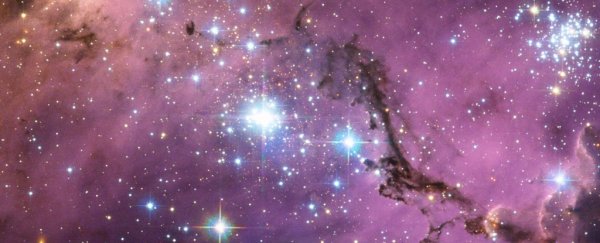The latest measurement of the expansion rate of the Universe is in, and it has confirmed with more certainty than ever that we have a real dilly of a pickle on our hands. Once again, the result has shown that the Universe is expanding much faster than it should be based on the conditions just after the Big Bang.
The Universe's rate of expansion is called the Hubble Constant, and it's been incredibly tricky to pin down.
According to data from the Planck satellite that measured the cosmic microwave background (the conditions of the early Universe just 380,000 years after the Big Bang, the Hubble Constant should be 67.4 kilometres (41.9 miles) per second per megaparsec, with less than 1 percent uncertainty.
There are a number of ways to derive the Hubble Constant. Edwin Hubble observed the Doppler shift of retreating nebulae - that is, the changes in the wavelength of light as the object moves farther away. But, in the decades since then, our methods have refined.
Now, calculations often involve the use of standard candles such as Cepheid variable stars, whose known luminosity allows for accurate distance calculations - and they have pretty consistently been returning results faster than the Planck data.
Last year, for example, a Cepheid variable calculation of the Hubble Constant returned an expansion rate of 73.5 kilometres (45.6 miles) per second per megaparsec.
This measurement reduced the possibility that the results were somehow mistaken to one in 5,000. Now we have a fresh result that narrows it down even further.
Using a new method with the Hubble Space Telescope, a team of astronomers calculated the absolute brightness of 70 Cepheid variables in the Large Magellanic Cloud more accurately than ever before.
With this data, they have derived a new Hubble Constant: 74.03 kilometres (46 miles) per second per megaparsec.
That's about 9 percent faster than estimates based on the Planck data. And the chance that the discrepancy is a fluke or an error is now just one in 100,000.
"The Hubble tension between the early and late Universe may be the most exciting development in cosmology in decades," said astrophysicist Adam Riess of the Space Telescope Science Institute (STScI) and Johns Hopkins University.
"This mismatch has been growing and has now reached a point that is really impossible to dismiss as a fluke. This disparity could not plausibly occur by chance."
Which means that there's something out there that we've missed. As a study last year deriving the Hubble Constant using black holes proposed, the acceleration could be the result of an increase in the density of dark energy.
This mysterious form of energy is thought to constitute around 70 percent of the matter-energy density of the Universe, and is the current most accepted explanation for the acceleration of the Universe's growth.
Or it could be that dark matter is interacting more strongly with normal matter than astronomers have accounted for.
But it could also mean that, yes, the result is just not explainable according to current physics. So some shiny new weird physics might be required.
"This is not just two experiments disagreeing," Riess said.
"We are measuring something fundamentally different. One is a measurement of how fast the Universe is expanding today, as we see it. The other is a prediction based on the physics of the early Universe and on measurements of how fast it ought to be expanding.
"If these values don't agree, there becomes a very strong likelihood that we're missing something in the cosmological model that connects the two eras."
The team's research has been accepted for publication in The Astrophysical Journal, and is available on arXiv.
